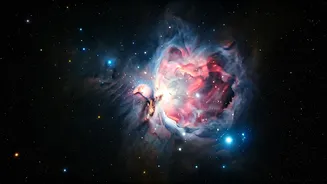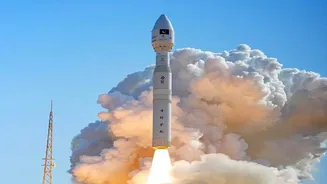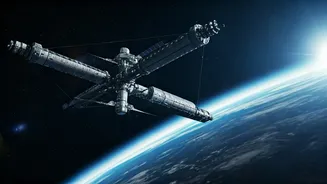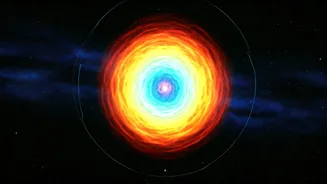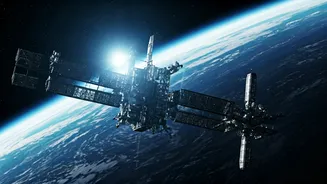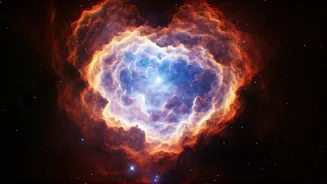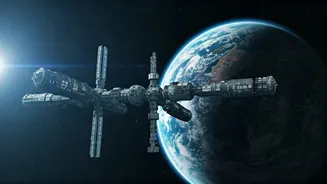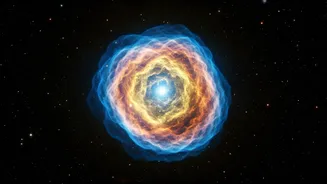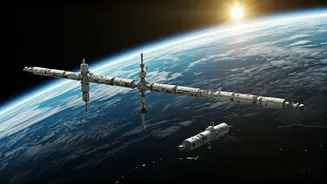Orbit Crowding Concerns
Low Earth orbit (LEO) is increasingly becoming a busy place, according to a recent study. This raises concerns about the potential for collisions and the increasing amount
of space debris. The presence of numerous satellites, along with the growing amount of space junk, presents a hazard to operational spacecraft and astronauts. Experts are ringing alarm bells about the potential risks posed by the increasing congestion of LEO. The challenge is in finding sustainable solutions for the burgeoning population of satellites. Debris mitigation strategies and stricter regulations may become necessary to protect the space environment and enable the continued exploration and utilization of space. The international community is keen to address this complex issue, seeking to ensure that space remains accessible and safe for future generations.
Space Warfare Possibilities
The discussion around space warfare has intensified recently, with some experts arguing that it's no longer just a hypothetical scenario but an area in which we see real activity. The movement of satellites for inspection purposes and the development of technologies to track and monitor objects in space are becoming increasingly common. This new realm of warfare involves not only the physical destruction of satellites but also cyberattacks and electronic warfare techniques. As nations continue to develop and deploy advanced space-based capabilities, the potential for conflict in space increases. Experts warn that posturing is a part of this game. The need for international cooperation and the establishment of clear rules of engagement are essential to prevent the escalation of tensions and ensure the peaceful use of space.
Moon Race Dynamics
The United States may face the challenge of losing the race to the Moon to China, according to expert opinions presented to the Senate. This competition is not just symbolic; it reflects the ambition of these countries and the strategic implications of dominating the lunar frontier. China's rapid advancements in space technology and its commitment to ambitious lunar exploration missions have put them in a position to possibly win this space race. The consequences of any country falling behind include missed opportunities for scientific discovery, economic development, and technological advancement. A strong focus on innovation, resource allocation, and international collaboration can help the US maintain its leadership in space exploration and remain competitive in this evolving arena.
Space Debris Solutions
Space debris poses a considerable threat to satellites and spacecraft, and various approaches are now being considered to handle this. One approach being developed is methods for de-orbiting space junk, which involves bringing non-functional satellites and debris back into the Earth's atmosphere. Countries and space agencies are investing in technologies like robotic arms, space-based nets, and even lasers to capture and remove space debris. International cooperation and the establishment of common standards are essential for the effective management of space debris, ensuring the sustainability of space activities for all. With continuous innovation and implementation of these solutions, the long-term viability of space exploration and utilization can be ensured.
New Space Technologies
Innovations in space tech are constantly emerging, including the development of potential 'Space Armor' designed to protect satellites and astronauts from space debris. Another area of innovation involves the implementation of deep space radars capable of tracking multiple satellites from a distance of 22,000 miles. With the development of these advancements, new avenues are opening for enhanced space exploration, increased safety, and better management of the space environment. Constant investment in research and development is vital for pushing the boundaries of what is possible in space. Such technologies are not just theoretical concepts, but are quickly becoming reality.
Celestial Wonders Observed
The cosmos continues to provide us with stunning visuals, including photographs of auroras captured from the International Space Station. The Hubble Space Telescope has also captured images of a glowing 'starburst ring'. The Orionid meteor shower is another event to look forward to, promising an impressive display for those who observe it. The sky reveals its mysteries and beauty at every turn, offering a unique opportunity to witness spectacular displays and astronomical phenomena. These occurrences inspire wonder and encourage further exploration of the universe, providing insights into the vastness and complexity of space.


